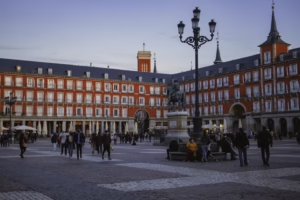Watch our video interview with Gaetano Grana
Do you speak Spanish? Don't miss our exclusive interview with Gaetano Grana, Terreta Spain's works manager. Watch it now!
Hello Gaetano, can you introduce yourself in a few words?
I am Gaetano Grana, an engineer with over 20 years of experience in building maintenance and public works, specializing in managing comprehensive renovation projects for real estate investment. Throughout my career, I have led key initiatives in cities such as Madrid, Barcelona, Seville, Alicante, and Malaga, working on both new constructions and the rehabilitation of social housing and cultural heritage. My passion and specialty focus on restoring the habitability of old homes, revitalizing them to meet the needs of the current market. This approach not only contributes to the recovery of the housing stock but also stimulates the economic and functional value of real estate, making it attractive to investors and owners.
What is the mission of Terreta Spain?
For me, the mission is to identify and manage real estate properties that offer income-generating opportunities for investors, creating innovative real estate solutions that meet the needs of clients, whether in terms of rental, purchase, or investment.
Regarding renovations, how does Terreta Spain differentiate itself from other construction companies?
It mainly differentiates itself through the level of exclusivity, personalization, and quality of the services we offer. These differences are reflected in several key aspects:
– Quality of materials.
– Custom designs that reflect the specific style and preferences of each client, working with quality architects, interior decorators, or designers.
- Qualified and certified workforce for each specific trade.
Who are your services for?
Our renovation services are aimed at various types of clients, depending on their approach. For example, there are those who wish to renovate, extend or modernise their homes, such as kitchens, bathrooms or communal areas, but also those who renovate to increase the value of the property in order to sell or rent at a higher price.
What are the main features of renovations in Spain?
Renovations in Spain have particularities linked to the characteristics of its architecture, local regulations, cultural trends and the climate of each city. Many homes in Spain are old or traditional buildings, especially those located in historical centres, which require special attention to respect their architectural value and comply with conservation regulations. In cities such as Valencia, Madrid, Barcelona and Seville, it is common to work with original structural elements such as high ceilings, wooden beams, stone walls, hydraulic floors or Nolla mosaics, restoring them or integrating them into modern designs. In tourist areas, such as the Costa del Sol or the Balearic Islands, renovations are often geared towards creating holiday homes or tourist rentals, with an emphasis on attractive design and durable materials for intensive use.
How has the sector been performing since Covid?
The renovation sector in Spain has seen a significant recovery after the initial impact of COVID-19. During the pandemic, there was an increase in household savings, which stimulated investment in home improvements. In 2020, the sector recorded growth in renovation requests, reaching an acceptable volume of business given the circumstances. This boom was stimulated by the need to adapt homes to make them more comfortable and functional, as people were spending more time at home due to health restrictions and teleworking.
What are the key steps for renovating a property in Spain?
Renovating a property in Spain involves several key steps to ensure an efficient process that complies with local regulations and is adapted to the client's needs. We could summarise them as follows:
- Property inspection
- Definition of objectives
- Renovation budget
- Licence management
- Execution of the renovation
- Monitoring and supervision
- Verification
- Interior decoration
- Delivery to the client
- Agreed guarantees
What types of properties do you renovate most often?
In Spain, the properties that are most often renovated are old homes in urban areas. This is due to several factors, such as the age of the housing stock; many homes in Spain are more than 40 years old, which requires both aesthetic and functional updates to adapt to current needs, such as improvements in energy efficiency, teleworking spaces or modern designs. Another important factor is the demand in large cities such as Madrid, Barcelona and Valencia, which are key points for renovations. Owners invest in renovating properties in these areas to increase their market value, whether for sale or rent. In some areas, renovations can increase the value of the property by up to 30%. In summary, renovations in Spain are dominated by old urban homes and properties seeking to increase their value through energy efficiency or adaptations to more modern lifestyles.
What type of renovations do you carry out most often: partial or total?
In Spain, both partial and full renovations are popular, but the choice depends on the specific needs and resources of the owners. Partial renovations are more common because they focus on specific areas, such as the kitchen, bathroom or aesthetic changes in a room. These renovations allow for immediate improvements with a lower initial investment, cost and execution time. They are ideal for those looking for specific updates without disrupting daily life too much. Full renovations, although they represent a higher investment, have gained ground due to the need to optimise spaces, improve energy efficiency and completely renovate old properties. Their advantages include the total transformation of the property, including the redesign of the distribution, the updating of technical systems and the customisation of finishes, which significantly increases the value of the property.
We hear a lot about licences and building permits. Can you explain what we need to know about this before starting a project?
Before starting a renovation project in Spain, it is essential to understand the licences and permits required to comply with local regulations. Here are the key points we need to know:
Types of building permits:
– Minor Works Permit: For work that does not affect the structure of the building or the common elements.
– Major Works Permit: For structural renovations, changes in the distribution of spaces, modifications to facades, or significant modifications to the common elements of buildings.
There are other variants such as type I and II responsible declarations, but the first two cover the majority of cases.
-Specific permits: in addition to basic licenses, additional permits may be required in certain situations, such as modifications in protected buildings or permits for occupying public roads for debris containers and/or scaffolding.
-Local regulations: each municipality may have specific requirements, so it is essential to consult local ordinances. For example, some municipalities require prior technical inspections or limit working hours to minimize disturbance to neighbors.
-Associated costs: licenses have a cost, generally calculated as a percentage of the works budget (around 2% – 4%). They may also include additional fees for waste management or the use of public space.
-Required documents: basic documents generally include: technical project (in the case of major works), works budget, responsible declaration or license application, proof of payment of fees.
What are the most common administrative errors made by foreigners who want to renovate in Spain?
Foreigners who wish to renovate or refurbish properties in Spain often make certain administrative errors due to differences in regulations and procedures. Here are the most common ones according to my experience:
– Lack of knowledge of local regulations.
– Confusion about the type of license to apply for.
– Failure to take into account regulations in protected buildings.
– Ignoring current energy efficiency standards.
– Not consulting true professionals.
– Failure to take into account additional costs related to hidden defects.
Are there restrictions or areas where it is more difficult to obtain building permits?
In Spain, there are areas and types of properties where obtaining building permits can be more complicated due to a series of specific regulations and restrictions. The main factors that affect obtaining building permits include:
– Heritage or historical protection zones.
– Areas with environmental protection.
– Areas with high population density.
– Buildings of interest and cultural heritage.
– Urban planning regulations that may vary depending on the municipality.
In Spain, can a condominium association oppose work in an apartment: true or false?
In Spain, a condominium association can indeed oppose certain works in an apartment if they affect the common elements of the building or do not comply with the regulations established in the Horizontal Property Law (LPH) or in the statutes of the condominium. However, there are important limits and exceptions to this rule, as it is actually the town hall that grants the work permits and licenses for a renovation.
What are the average renovation costs per square meter in Spain in 2024?
In Spain, the average cost of a complete renovation in 2024 varies depending on factors such as location, type of materials, and quality of finishes. For a standard complete renovation, prices per square meter generally range between €600 and €800/m² + VAT. However, for high-end projects, costs can exceed €1,000 or even reach €1,200 per square meter + VAT.
What are the most common unforeseen expenses in a renovation project and how can they be anticipated?
I believe the most common are those related to hidden structural problems. These can be anticipated by conducting surveys for preliminary inspections before preparing quotes. Other unforeseen expenses may include the need to update old installations, unforeseen issues in plumbing or electricity, and possible modifications needed once work begins on the property.
What are the main risks faced by property owners during renovations in Spain?
First, the risk of not obtaining the necessary permits to carry out their project. Then, there are the cost overruns that can be generated by hidden defects, which are only discovered once work has begun. And sometimes, the opposition of a part of the condominium to carry out the work or condition it, especially in communities with strict rules.
What are the advantages of renovating an old property rather than buying a new property in Spain? (Profitability and others)
Renovating an old property in Spain can offer significant advantages compared to buying a new property. These advantages include profitability, personalization, and sustainability.
- Profitability: Renovating a property can significantly increase its value, especially in central areas where old properties are more sought after.
- Location: Old properties are often located in city centers, where the supply of new constructions is limited.
- Personalization: Renovating an old property allows designing spaces according to the owner's style and needs, which is not always possible in new properties, which are often standardized.
- Sustainability: Renovating an existing property involves reusing resources and materials, which reduces the carbon footprint compared to constructing a new property.
In summary, renovating an old property is a strategic decision, especially for those looking to maximize their return on investment, personalize their home, and enjoy privileged locations. However, it is essential to plan the work well and consult professionals to guarantee a successful result.
How can renovations increase the value of a property in Spain, both for purchase and for rental?
Renovations significantly increase the value of a property if certain fundamental aspects are taken into account:
- Updating installations: Renovating systems such as electricity, plumbing, and heating not only improves safety but also ensures that the property meets current standards.
- Redistribution of spaces: The trend towards open spaces and integrated kitchens improves the functionality and aesthetics of the property, thus increasing its attractiveness on the market.
- Renovation of bathrooms and kitchen: These areas have a major visual and practical impact. Tenants often prioritize these spaces, especially if they have modern and functional finishes.
How does your renovation company work and what guarantees do you offer to your clients?
At Terreta, we specialize in projects offering a superior level of design, quality, personalization, and customer service. We focus on creating exceptional results for demanding clients, such as owners, investors, or companies seeking high-end finishes, as well as exclusive support and technical advice.
Our guarantees include:
- The quality of the work.
- Adherence to deadlines.
- Financial transparency.
- Legal guarantees on the work performed.
- Protection against damage to third parties or property during the work.
What advice would you give to someone looking to renovate a property in Spain to avoid common mistakes?
Renovating a property in Spain can be a rewarding but challenging process. To avoid common mistakes, here are some key tips based on my experience:
- Define a clear plan: Know exactly what you want to achieve with the renovation.
- Establish a realistic budget: Consider all costs, including unforeseen expenses.
- Avoid changes during the works: Changing the plan during construction can lead to delays and additional costs.
- Comply with standards and obtain the necessary permits: Ensure that the works comply with local legislation.
- Choose the right professionals: It is crucial to work with qualified professionals and avoid trying to reduce costs too much, which could compromise the quality of the work.
A successful renovation requires planning, good professionals, and a clear understanding of local regulations. Investing time in these aspects before starting can save you money, stress, and avoid legal problems in the long term.
Do you observe specific trends in renovations in Spain, such as sustainability or the use of specific materials?
In Spain, current renovation trends show a strong emphasis on sustainability, energy efficiency, and the use of both innovative and traditional materials. These trends are dictated by homeowner demand, government regulations, and changing post-pandemic priorities. Key trends include:
- Multifunctional spaces and open designs: Integration of rooms such as the kitchen/living room.
- Valorization of traditional elements: Nolla mosaics, wooden beams, Catalan vaults, hydraulic floors.
- Incorporation of technology: Air conditioning, home automation, smart home systems.
- Emphasis on outdoor spaces: Optimization of terraces and patios.
- Colors and interior design: Earth tones, beige, and gray, often combined with black or gold details.
How has international demand influenced working methods and expectations for renovations?
International demand has had a significant impact on working methods and expectations for renovations in Spain. This phenomenon is mainly due to foreign buyers and investors who acquire properties for personal use, holidays or as rental investments.
International clients, especially those from Northern Europe, favor sustainable solutions, which has promoted the adoption of environmentally friendly materials, renewable energies and efficient systems.
This demand has transformed the renovation sector in Spain, establishing higher standards in terms of quality, sustainability and professionalism.
Companies like Terreta have adapted their services to meet this client profile, which has benefited both foreign buyers and the market in general.
At Terreta, if the investor needs it, we carry out "turnkey" projects, which is an advantage for many foreigners who cannot be present throughout the renovation process. In addition, language can often be an obstacle at this stage, which is why we offer a service in several languages (English, Italian, French, etc.), trained to meet the cultural and practical needs of foreigners.







